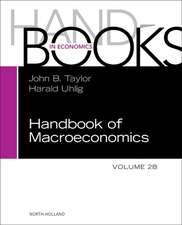Introduction to Quantitative Macroeconomics Using Julia: From Basic to State-of-the-Art Computational Techniques
Autor Petre Caraianien Limba Engleză Paperback – 29 aug 2018
- Combines an introduction to Julia, with the specific needs of macroeconomic students who are interested in DSGE models and PhD students and researchers interested in building DSGE models
- Teaches fundamental techniques in quantitative macroeconomics by introducing theoretical elements of key macroeconomic models and their potential algorithmic implementations
- Exposes researchers working in macroeconomics to state-of-the-art computational techniques for simulating and solving DSGE models
Preț: 425.42 lei
Preț vechi: 593.00 lei
-28% Nou
81.41€ • 85.21$ • 67.75£
Carte tipărită la comandă
Livrare economică 24 martie-07 aprilie
Specificații
ISBN-10: 0128122196
Pagini: 238
Dimensiuni: 216 x 276 x 12 mm
Greutate: 0.56 kg
Editura: ELSEVIER SCIENCE
Public țintă
Graduate students of macroeconomics and professionals working with quantitative macroeconomicsCuprins
1. Introduction to Julia 2. Basic Numerical Techniques 3. Solving and Simulating DSGE Models 4. Dynamic Programming 5. Advanced Numerical Techniques 6. Heterogeneous Agents Models
Recenzii
"Julia is a computer language that is taking economics by storm. In this book, Petre Caraiani takes the reader by their hands and introduce them to a wide variety of numerical methods that are then applied to recent macroeconomic models. The book explains these methods and applies them in Julia not only those models with representative-agent (RBC and DSGE models), but also to heterogeneous-agents models. Therefore, the book is a valuable source for readers interested in numerical methods and in Julia." --Pedro Garcia Duarte, University of São Paulo
"Petre Caraiani’s book guides the readers into the sophisticated and innovative field of quantitative macroeconomics with the aim of bridging the gap between theoretical models and modern computational techniques. Caraiani provides an outstandingly clear exposition of the numerical methods by which researchers and graduate students can approach the complex problems of solving DSGE models or setting up heterogeneous agents models. This book is a must for all those who are interested in making theoretical macroeconomics an empirical discipline." --Peter Galbács, Budapest Business School
"This book provides an excellent overview of key numerical tools to study macroeconomic models and provides supporting programs using Julia, a frontier programming language." --Wouter den Haan, London School of Economics
"This book provides a clear and comprehensive introduction to the numerical techniques that every student that aims at doing quantitative economics should know. Not only the book provides with a minimal introduction to the theory underlying these methods, but it also offers many examples, all coded in a modern language, Julia. This book is definitely a good reference for whoever needs a quick and nice introduction to these techniques." --Fabrice Collard, University of Bern
"This new book by Petre Caraiani is a very welcomed contribution that takes the reader on a journey through computational economics, from basic numerical techniques to Heterogeneous Agents Models, while learning how to master the new and fast programming language Julia." --Alberto Russo, Universita Politecnica delle Marche
Descriere
Introduction to Quantitative Macroeconomics Using Julia: From Basic to State-of-the-Art Computational Techniques facilitates access to fundamental techniques in computational and quantitative macroeconomics. It focuses on the recent and very promising software, Julia, which offers a MATLAB-like language at speeds comparable to C/Fortran, also discussing modeling challenges that make quantitative macroeconomics dynamic, a key feature that few books on the topic include for macroeconomists who need the basic tools to build, solve and simulate macroeconomic models. This book neatly fills the gap between intermediate macroeconomic books and modern DSGE models used in research.
- Combines an introduction to Julia, with the specific needs of macroeconomic students who are interested in DSGE models and PhD students and researchers interested in building DSGE models
- Teaches fundamental techniques in quantitative macroeconomics by introducing theoretical elements of key macroeconomic models and their potential algorithmic implementations
- Exposes researchers working in macroeconomics to state-of-the-art computational techniques for simulating and solving DSGE models



















